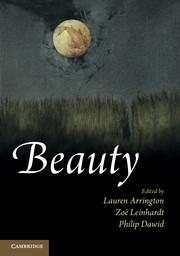Book contents
- Frontmatter
- Contents
- Notes on contributors
- List of figures
- Introduction
- 1 Beauty and truth: their intersection in mathematics and science
- 2 Beauty and the grotesque
- 3 Quantum beauty: real and ideal
- 4 The sound of beauty
- 5 Beauty and attraction: in the ‘eye’ of the beholder
- 6 Beauty and happiness: Chinese perspectives
- 7 Terror by beauty: Russo-Soviet perspectives
- 8 The science and beauty of nebulae
- Index
- References
6 - Beauty and happiness: Chinese perspectives
Published online by Cambridge University Press: 05 June 2014
- Frontmatter
- Contents
- Notes on contributors
- List of figures
- Introduction
- 1 Beauty and truth: their intersection in mathematics and science
- 2 Beauty and the grotesque
- 3 Quantum beauty: real and ideal
- 4 The sound of beauty
- 5 Beauty and attraction: in the ‘eye’ of the beholder
- 6 Beauty and happiness: Chinese perspectives
- 7 Terror by beauty: Russo-Soviet perspectives
- 8 The science and beauty of nebulae
- Index
- References
Summary
When I received the invitation to speak as part of the Darwin College lecture series on Beauty, I was deeply conscious of the honour paid me, but apprehensive. I was afraid I had nothing new or original to say, because both beauty and happiness have been discussed or represented by philosophers and artists at different times and places throughout human history. As I prepared my lecture, I also remembered what Walter Pater wrote in 1893 in his preface to The Renaissance: Studies in Art and Poetry: ‘Beauty, like all other qualities presented to human experience, is relative; and the definition of it becomes unmeaning and useless in proportion to its abstractness.’
As a postgraduate fellow at the Freer Gallery of Art in Washington in the late 1970s, every day I had to use an entrance hidden behind one of the walls of the Peacock Room (Figure 6.1) to reach my small office. The Peacock Room was designed by James Whistler (1834–1903) as the dining room for his patron, Frederick Richards Leyland (1831–92); it was later dismantled and was sold eventually to Charles Lang Freer (1854–1919). In 1923 it was reinstalled in the Freer Gallery of Art. Seeing the Peacock Room daily gave me ample opportunity to think about beauty and happiness. First of all, it compelled me to contemplate what the French writer Stendhal wrote on several occasions: beauty is nothing other than the promise of happiness. It also reminded me of John Ruskin’s assertion in Stones of Venice: ‘Remember that the most beautiful things in the world are the most useless; peacock and lilies, for instance.’ The blue and white porcelains in the Peacock Room also evoked the ‘china-mania’ initiated by Whistler and his contemporaries. The fact that blue-and-white porcelain, most of it mass produced in Chinese factories for export and considered quite unremarkable by Chinese connoisseurs, caused such a sensation in Europe from the seventeenth century onward made me wonder if there is such a thing as universal beauty.
- Type
- Chapter
- Information
- Beauty , pp. 119 - 142Publisher: Cambridge University PressPrint publication year: 2013

